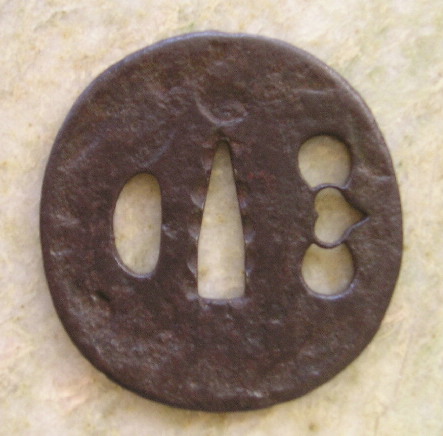
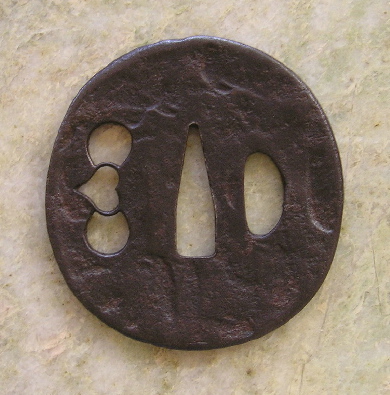 |
  |
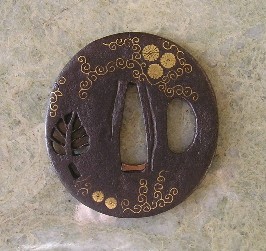 
|
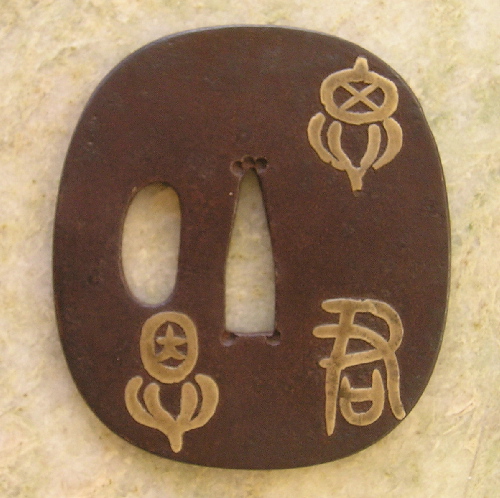 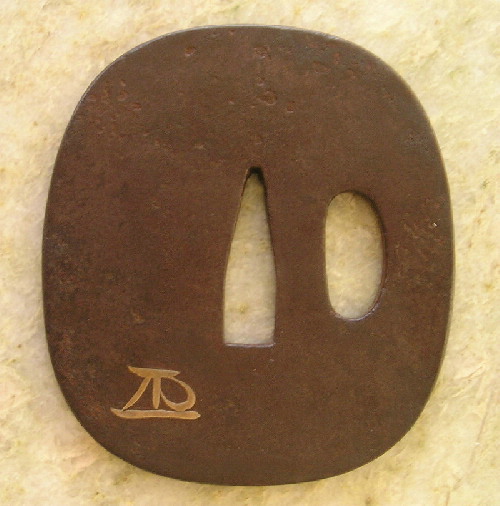 |
EARLY INLAYS:
ONIN, FUSHIMI, YOSHIRO, TEMPO,
HEIANJO, KAGA, GOMOKU ZOGAN, SHOAMI, AND AWA
It has become customary to class under the heading FUSHIMI-YOSHIRO all iron guards decorated in flat hirazogan of brass or in high relief of brass, which were made in the town of Fushimi in Yamashiro, where in 1589 Hideyoshi built his castle, and whither artists and artisans flocked in great numbers. However, this term includes such different types that a narrower classification is more desirable. , In the fifteenth century certain guards were made known as Onin tsuba, so called from the name of the period Onin (1467-68). The inlay is flat, either of copper, brass, or sentoku. These tsuba are usually thin in the web bounded by a rounded rim, and decorated with simple motives. An example in this collection is inlaid on either side in copper with a design of a horse's halter. The term Fushimi tsuba generally describes those guards in which the designs of flowers, scrolls, cloves, and other decorations are inlaid in flat hirazogan of brass, while Yoshiro is applied to those which are in higher relief and especially to the tsuba in which crests (mon) in open work and inlay form the decoration. Both of these types probably date from the sixteenth century. The name Yoshiro is derived from that of Koike Yoshiro who also signed his work Naomasa with the title Izumi-no-Kami, and who must have originated this style of decoration. M. de Tressan cites a tsuba with the signature of Yoshiro and the date 1533. It is in the collection of M. Jacoby of Berlin. An interesting Fushimi tsuba made of iron and carved in the round so that the solid portion forms the mitsu-tomoye, a design whose meaning has been discussed at length. Each comma-shaped figure is inlaid in brass with an arabesque design of vines bearing the leaves and fruit of the gourd, a motive known to have been a favorite one of Hideyoshi, the general, who was ruling Japan at that time from his palace in Fushimi. The inlay is flat, and fine lines of surface engraving, called kebori, bring out the veins of the leaves. Another tsuba, also of Fushimi style, is of a size larger than is ordinary, being in form square with rounded corners. On both sides, in low relief of brass, there are designs of broken folding fans (ogi) the remaining portions of which are decorated with water lines and flecks of foam chiselled in kebori.
This decoration, the riddled ogi, probably refers to the incident which occurred at the battle of Dan-no-ura. Antoku, the boy emperor, had been given a fan decorated with a red sun-disk of the Kami, which the priest of Itsukushima declared would divert any arrows and thus protect the Taira boats. Accordingly, at the battle, the fan was secured to a bamboo pole and placed in the bow of the first ship, as they proceeded against the Minamoto. Some accounts have it that a beautiful girl stood just below the fan. Nasu-no- Yoichi of the Minamoto clan accepted the challenge, and riding into the waves, raised his bow and let fly his arrow, shattering the fan to pieces. Thus with this foreboding opening began the battle in which the power of the Taira family was hopelessly crushed and the might of the Minamoto established.
One of the earliest uses of brass inlay seems to have been used on tsuba in this period. Circular in form, it is divided into twelve sections, in six of which is hammered a crudely formed plum-blossom. The six other divisions are adorned with small bosses of brass in low relief, and the fields are outlined, as is the entire tsuba, with an uneven line of brass. Two tsuba of similar treatment are assigned by H. Joly and K. Tomita1 to the sixteenth century. The brass reliefs on Yoshiro guards are generally higher than those found on tsuba of the foregoing group. Conventionalized floral designs are common decorations. This mokko-formed tsuba recalls the aoi form, perforated as it is with the four aoi leaves. The aoi outline is accentuated by a line of brass relief carved to represent a rope. The flowers and leaves which appear on both sides of the guard are finished with kebori chasing. Many Yoshiro tsuba are decorated with plum sprays, ginko leaves, and the blossoms of the Chinese bell-flower, kikyo (Platycodon grandiflora), which appear on this specimen. Examples of so-called Tempo tsuba may properly be listed among the early inlays, as the decoration on these particular guards is a peculiar type of incrustation of hammered brass. Tempo tsuba likewise were produced in the province of Yamashiro, probably at Sanoda, in the seventeenth century, although they are said to have originated during the second half of the sixteenth century in Nara, where an artist Tembo (Ten ho) worked; he decorated his tsuba with figures stamped with a die before the final heating of the steel. The character tern appears most frequently upon these guards. This unusual method is employed by Hirokuni, an eighteenth-century artist of Sendai, by Mitsuhaya (nineteenth century) of Kyoto, and by Kiami, an eighteenth-century worker in Aki.
The TEMPO tsuba is of iron with a surface made uneven by carving and stamping. Scattered along the edge of the guard are patches of brass in forms suggesting clouds which are broken by small punch-marks. At least two dies have been applied in stamping the iron, but the impressions of the characters are too incomplete for decipherment. In the late sixteenth or early seventeenth century, several Fushimi artists and artisans moved to the capital Kyoto, whose classic appellation is Heianjo. This name appears before the signatures of certain makers of iron tsuba, decorated, for the most part, with flat inlays of brass depicting animals and birds, sometimes treated in a grotesque manner. Similar subjects were executed by later Heianjo artists in chasing in the round (ntarubori). Occasionally touches of gold (nunome-zogan) were applied to portions of these sculptured pieces, as is the case in an iron tsuba in this collection: here three galloping ponies are carved in the round and spotted with gold inlay. Though the early Kaga artists are said to have originally migrated from Fushimi and settled in Kanazawa in the early seventeenth century, there is little in the typical work of this school to suggest the rather crude inlays which have been described above. Kaga artists are generally famed for the accuracy of their excellent hirazogan. Undoubtedly they owe much of their refinement in color, design, and workmanship to the influence of Goto artists, who were at that time creating their famous reliefs in the precious metals, and some of whom were also working in the province of Kaga. The earliest Kaga work is generally accomplished in iron with inlays of sentoku or silver, which produce a beautiful and brilliant effect. As the influence of the Goto artists increased, shakudo, shibuichi, and copper were preferred for the ground of the tsuba, in which metals of varying shades were inlaid in a variety of design. A charming characteristic of this work is the combination of inlay and kebori. It is quite common to find, especially on kozuka, a design inlaid on the obverse and, on the reverse, a continuation or supplementation of the motive executed in the fine hair-line engraving.
"The schools of KAGA were numerous. Early in the seventeenth century, Goto Kenjo's pupil, Ujiye Gondayu founded the Katsuki. Another of Kenjo's pupils started the Kuwamura group; a pupil of Takujo initiated the Kuninaga school; and Yoshihisa, pupil of Yenjo, began the Mizuno family in the Genroku period (1668- 1703). Five or six groups of less importance might be mentioned, besides a large number of independent workers." Among the earliest masters, Yoshishige, who used the name Gorosaku, and Kuninaga, who sometimes signed his work Jirosaku, should be pointed out. Both these artists were chisellers and inlay-workers for the daimyo of Kaga, and worked in the first half of the seventeenth century. In two unsigned examples of Kaga work, the ground metal in each case is copper. The tsuba which belongs to the late eighteenth century, is circular with riohitsu plugged with shakudo. Inlaid in flat hirazogan with kebori are silver peonies with leaves of shakudS veined in fine lines of gold. At the right on the obverse side is a split bamboo curtain (sudare) inlaid in dark silver with bindings of shakudo in which fine thread-like designs are inlaid with gold. Above hangs the tying cord with tassels in silver zogan with kebori. On the reverse side of the tsuba the peony motive is continued, with the addition of three flying butterflies in gold and silver. The kozuka, also of late eighteenth-century workmanship, is a happy combination of inlay and chasing. On the obverse in flatly engraved inlay of gold and silver are a butterfly, dragonfly, grasshopper, and two roaches, while on the reverse side branches of a species of valerian (ominameshi) and grasses are engraved in kebori. A peculiar form of incrustation appears in early Kaga work combined with crests. It is called gomoku-zogan (literally, "dirt inlay"). It has been described as representing broken pine-needles or frost-work (shimofuri), and consists of scraps of brass wire and filings scattered over the iron field. On the examples belonging to this collection it forms the sole decoration, appearing without the Kaga crests. The futatsu tomoye is again the motive chiselled in openwork in the thin iron guard. Scraps and bits of brass wire are scattered on the edge and a portion of the centre of this tsuba, which is rather an unusual form to be decorated with gomoku-sogan. It was most likely made in the late sixteenth or early seventeenth century, long before the Kaga artists had developed their skill in hirazogan of precious metals.
Though the SHOAMI school was organized in Kyoto in the seventeenth century, work typical of this group of artisans seems to have been done in many different parts of Japan, where later followers set up their own ateliers in their native provinces. The school was founded by Masanori, who produced tsuba in inlay after the manner of Umetada Myoju (p. 68) with whom he is said to have worked. Certain pieces executed in low relief with inlays also bear his name. By many critics Shoami tsuba are considered as inferior to the products of most of the other schools ; nevertheless they have made their appeal to many, as may be seen in studying the average collections of sword-fittings. The designs seem to be the common ones used on tsuba, an individual characteristic, however, being the cloud-like designs usually cut out in these guards. Much of the work resembles that of Fushimi or Yoshiro tsuba, though the designs are more freely drawn and of a wider range. Reliefs sculptured from the iron itself are also frequent. The list of Shoami workers is long; among the outstanding figures are Morikuni, Moritomi, Shigesada, and Dennai. Shoami Aizu no ju, "Shoami living in Aizu" (a district of the province of Iwashiro) is the signature incised on a circular iron guard, with three cloud forms chiselled in openwork and decorated with various shells in relief of shakudo and copper (Plate XII, Fig. 2). Water lines are suggested by delicate gold nunome,—a process which was used with extreme skill by the following group of artists. There is in this collection an iron tsuba on whose entire surface tendrils and blossoms of the kiri (Paulownia imperalis) are carved. It is signed "Shoami Kanenori," an artist hitherto unlisted in the records. The kiri design very often appears on Shoami tsuba.
Most of the inlay work designated AWA is done in nunome on iron in contrast to the true hirazdgan of the Kaga craftsmen. This school is a branch of the Shoami, having been founded by Tansai, in the late seventeenth or early eighteenth century. Much of the product of this school is in inlay on openwork designs of trees and boats, two popular and attractive types also consisting of screens or fan forms carved in iron and inlaid with all-over patterns in different shades of gold. Many 58 Japanese Sword-Mounts Awa tsuba are said to have been made for presentation purposes, in which case they were lavishly decorated, being called "Kenjo" tsuba, a name applied to those made for presentation to the shogun (see also Kinai School, p. 83). The designs chosen are very often of extreme delicacy ; and the accomplishment of the artist, working with iron as a foundation, calls forth real admiration.

 |
  |
 
|
  |
Return to TSUBA Go to Study Guide Email to Shibui Swords |